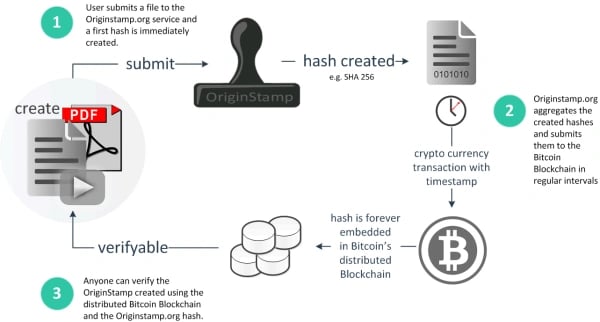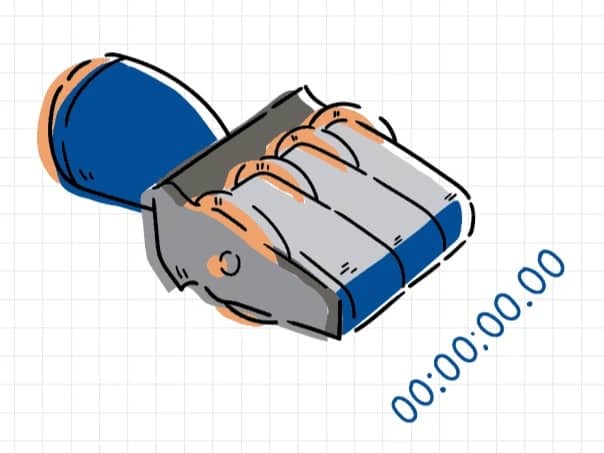위키 구독하기
Share wiki
Bookmark
Timestamp
에이전트 토큰화 플랫폼 (ATP):에이전트 개발 키트(ADK)로 자율 에이전트 구축
Timestamp
블록체인 기반 타임스탬핑은 특정 날짜와 시간에 데이터가 존재했음을 증명하기 위해 블록체인에 데이터를 기록하는 프로세스입니다. 블록체인 기반 타임스탬핑 서비스는 기업이 문서의 존재 증명을 제공하는 혁신적인 방법입니다. 또한 조직에서 법적 계약, 특허 및 기타 중요한 기록을 추적하는 데에도 사용됩니다. 타임스탬프 기록은 문서에 대한 발신자 또는 수신자의 디지털 서명이며, 공개 키 기반 구조(PKI)에 대해 검증할 수 있습니다.[1]
개요

블록체인 기반 타임스탬핑은 데이터에 대한 타임스탬프를 생성한 다음 블록체인에 저장함으로써 디지털 타임스탬핑의 보안을 향상시킵니다. 이 혁신은 데이터에 대한 타임스탬프를 생성하고 단순한 컴퓨터 서버에 저장하는 대신 분산 네트워크에 보호함으로써 디지털 타임스탬핑의 보안을 향상시킵니다.
블록체인 기반 타임스탬프에는 몇 가지 주요 이점이 있습니다.
- 원장에 게시된 후에는 변경하거나 제거할 수 없으므로 더 안정적이고 안전합니다.
- 블록체인은 분산되어 있으므로 어떤 한 당사자의 조작 가능성을 최소화합니다.
- 원하는 경우 타임스탬프를 완전히 투명하게 볼 수 있습니다.
전통적인 타임스탬핑과 블록체인 기반 타임스탬핑을 비교하는 쉬운 방법은 제조 회사의 예를 살펴보는 것입니다. 일반적으로 제조 회사는 자체 중앙 집중식 서버에서 제조 프로세스의 여러 단계를 추적합니다. 여기서 데이터가 손실되거나 손상되거나 조작될 수 있으며, 잠재적으로 타임스탬프에 대한 불신으로 이어질 수 있습니다. 반면에 분산된 분산 네트워크를 사용하는 블록체인은 변경할 수 없는 방식으로 소스에서 암호화된 데이터를 보호합니다. 안전하고 불변하며 투명한 데이터에는 신뢰가 따르며, 이것이 궁극적인 이점입니다.
역사
우표와 애너그램
타임스탬핑은 21세기에 처음 등장한 아이디어가 아닙니다. 사실 사람들은 역사적으로 문서를 안전하게 추적하고 인증하는 방법을 찾아왔습니다. 우표는 매우 조잡한 방식이지만 타임스탬핑의 전조이자 최초의 활용으로 간주됩니다. 사람들이 문서에 대한 소유권을 주장하려고 시도한 최초의 '실제' 시기는 17세기였습니다. 많은 과학자들이 혁신적인 발견에 대한 특허를 받거나 소유권을 증명하기 위해 자신에게 편지를 보냈습니다. 예를 들어, 로버트 훅(Robert Hooke)은 1660년 훅의 법칙(Hooke's Law) 발견의 증거로 애너그램을 발표했습니다. “훅은 처음으로 탄성 법칙을 애너그램으로 발표했습니다.” 10년 이상이 지난 후, 유명한 과학자 아이작 뉴턴(Isaac Newton)도 마찬가지로 전보를 통해 자신의 아이디어를 보호하려고 했습니다. 1677년 라이프니츠(Leibniz)에게 보낸 편지에서 그는 '플럭셔널 기법(Fluxional Technique)'을 설명하면서 암호화하여 자신의 발견을 은폐했습니다.
타임스탬핑을 위한 중앙 집중식 인프라
컴퓨터의 등장으로 우리는 타임스탬핑의 최초 실제 구현 중 하나를 볼 수 있었습니다. 그러나 이러한 방법 중 어느 것도 충분히 안전하지 않았습니다. 주요 문제는 중앙 집중식 인프라가 필요하다는 것이었습니다. 이러한 시스템은 타임스탬프 암호화에 복잡한 방법을 사용했음에도 불구하고 본질적으로 데이터 조작으로 이어집니다. 이 문제를 해결하는 유일한 방법은 분산화였으며, 블록체인 네트워크는 지금까지 분산형 타임스탬핑의 유일한 실용적인 구현입니다.
블록체인
블록체인 기술은 대량의 정보를 처리하기에는 너무 비효율적인 전통적인 공증인을 완전히 대체할 가능성이 있습니다. 디지털 버전은 1990년대 초 전자 공증인의 형태로 처음 등장했습니다. 그러나 전자 공증인이나 현대 공증인 모두 데이터 승인, 조달 및 처리를 안전하거나 비용 효율적으로 만들 수 있는 속성을 가지고 있지 않습니다. 블록체인 기반 타임스탬핑은 원래 비트코인의 생성과 함께 등장했습니다. 그 블록체인 네트워크를 통해 원장 내 모든 트랜잭션에 대한 타임스탬프를 생성할 수 있었습니다. 이를 통해 트랜잭션이 생성된 시점과 내용을 정확히 알 수 있는 일종의 존재 증명(Proof of Existence)이 가능해졌습니다.[2]
잘못된 내용이 있나요?
